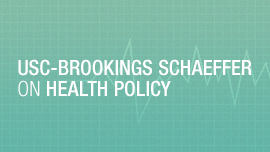This analysis is part of the USC-Brookings Schaeffer Initiative for Health Policy, which is a partnership between Economic Studies at Brookings and the University of Southern California Schaeffer Center for Health Policy & Economics. The Initiative aims to inform the national health care debate with rigorous, evidence-based analysis leading to practical recommendations using the collaborative strengths of USC and Brookings. This piece originally appeared in Health Affairs on February 3, 2021.
On January 21, President Biden kicked off his administration by outlining a new strategy to combat COVID-19. As part of this strategy, Biden issued an Executive Order that appears aimed at revisiting Trump administration guidance that exempted health plans from having to cover without cost-sharing COVID-19 testing for individuals who lack symptoms, a doctor’s order, or when conducted for return-to-work or public health surveillance purposes.
While most attention is focused on vaccines nowadays, widespread and frequent worksite, school, and community testing remains a vital tool to help suppress the virus and allow for safer in-person work and schooling until vaccination reaches a large enough share of the population. Fortunately, the Biden administration recognizes this, making mass testing a key pillar of their plan.
The most efficient and equitable way to conduct testing on a mass scale is through a federally-funded public effort that tests everyone, regardless of insurance status, but until Congress enacts such a program, mandating insurance coverage is an important lever to improve access to testing. Today, too many Americans are facing unexpected and often hefty fees for COVID-19 tests.
Yet the Families First and Coronavirus Relief Act (FFCRA), as amended by the Coronavirus Aid, Relief, and Economic Security (CARES) Act, is clear that private insurers must cover without cost-sharing all COVID-19 testing and any associated medical services without “prior authorization or other medical management requirements.” Many argued that the Trump administration guidance was contrary to this requirement.
Mandating that insurers cover and waive cost-sharing for more COVID-19 tests is a welcome policy change, but a few gaps remain that likely require Congressional legislation to address.
Guarantee Free Testing For The Uninsured
FFCRA established two pathways to pay providers for COVID-19 testing of uninsured patients. States are given the option of enrolling patients in a limited Medicaid benefit to pay for testing with a 100% federal match, but the process can be cumbersome and to date only 17 states have adopted it, according to Kaiser Family Foundation. In the remaining states, and as a backstop for uninsured patients not picked up by the Medicaid option, FFCRA and subsequent legislation established a $2 billion fund to pay for uninsured patient COVID-19 testing at rates similar to Medicare’s. That fund is currently being run through the Health Resources & Services Administration (HRSA). Some of the Provider Relief Fund is also allocated for testing the uninsured.
Nothing, however, requires providers to seek payment from the HRSA fund if the provider would rather bill the uninsured patient. And the above options leave some smaller gaps, including those enrolled in limited Medicaid benefits (e.g., family planning benefits) in states that did not take up the Medicaid option and individuals enrolled in certain forms of substandard coverage (such as short-term plans) that are exempt from much insurance regulation.
Legislation should require that free testing be made available to those enrolled in substandard health plans or limited Medicaid benefits. Further, legislation should prohibit the billing of any consumer for uncovered COVID-19 testing and associated services and add additional money to the HRSA fund to compensate providers, as needed.
End The Out-Of-Network Loophole
In order to guarantee COVID-19 is free for privately insured patients, laws must also address payment and balance billing for out-of-network testing. In a misguided attempt to address this issue, the CARES Act mandated that insurers pay any price a provider charges, so long as the provider lists the amount publicly on their website. This effectively creates an incentive for out-of-network labs and facilities to price gouge. Extreme abuses appear relatively uncommon, likely due at least in part to the desire of most labs and facilities to do business with insurers in the future, but they are far from non–existent.
If insurers are required to cover all tests, regardless of where and who administers them, then Congress must place a cap on how much providers can charge for COVID-19 tests. The Biden administration’s push for broader coverage of testing makes fixing this loophole all the more imperative.
Thankfully a fix is straightforward. When pursuing widespread testing through the insurance model (rather than through direct government support), there is good reason to require, temporarily, generous out-of-network COVID-19 test payment to support a greater supply of testing, particularly from smaller labs with higher marginal costs that insurers have little incentive to contract with. Therefore, to fix the out-of-network loophole, for the duration of the public health emergency, Congress should mandate that private insurers pay out-of-network labs and facilities three or four times average in-network prices for COVID-19 tests (or, equivalently but administratively simpler, three or four times Medicare prices given that private insurers tend to pay prices similar to Medicare’s for lab tests). In turn, out-of-network providers should be prohibited from balance billing patients.
Fund Back-To-School Testing Through Public Programs
For regular testing of schoolchildren, a key pillar of the Biden administration strategy, the insurance-based model is even less optimal. Collecting insurance information from this population is administratively challenging and many are covered by Medicaid or CHIP, adding to state budget woes if those programs have to cover testing on such a wide scale. If Congress is unable to establish a public fund to purchase testing services population-wide, it should consider doing so, at a minimum, for schoolchildren. The fund would purchase the tests on behalf of schools and the costs could be financed in part by an assessment on health plans.
A return to normalcy is in sight, but a significant ramp up in testing can help us get there that much faster. That means taking cost out of the equation for consumers, while balancing financing obligations among payers, providers, and the government.
Disclosures: The authors did not receive financial support from any firm or person for this article or from any firm or person with a financial or political interest in this article. They are currently not an officer, director, or board member of any organization with an interest in this article.
The Brookings Institution is committed to quality, independence, and impact.
We are supported by a diverse array of funders. In line with our values and policies, each Brookings publication represents the sole views of its author(s).






Commentary
Expanded coverage for COVID-19 testing must include limits on costs
February 3, 2021